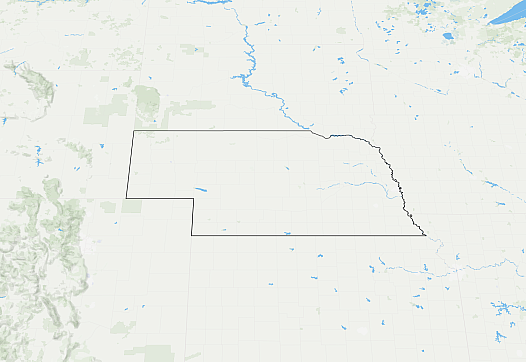Our Dirty Water
The story was originally published in Flatwater Free Press with support from the USC Annenberg Center for Health Journalism’s 2022 National Fellowship.
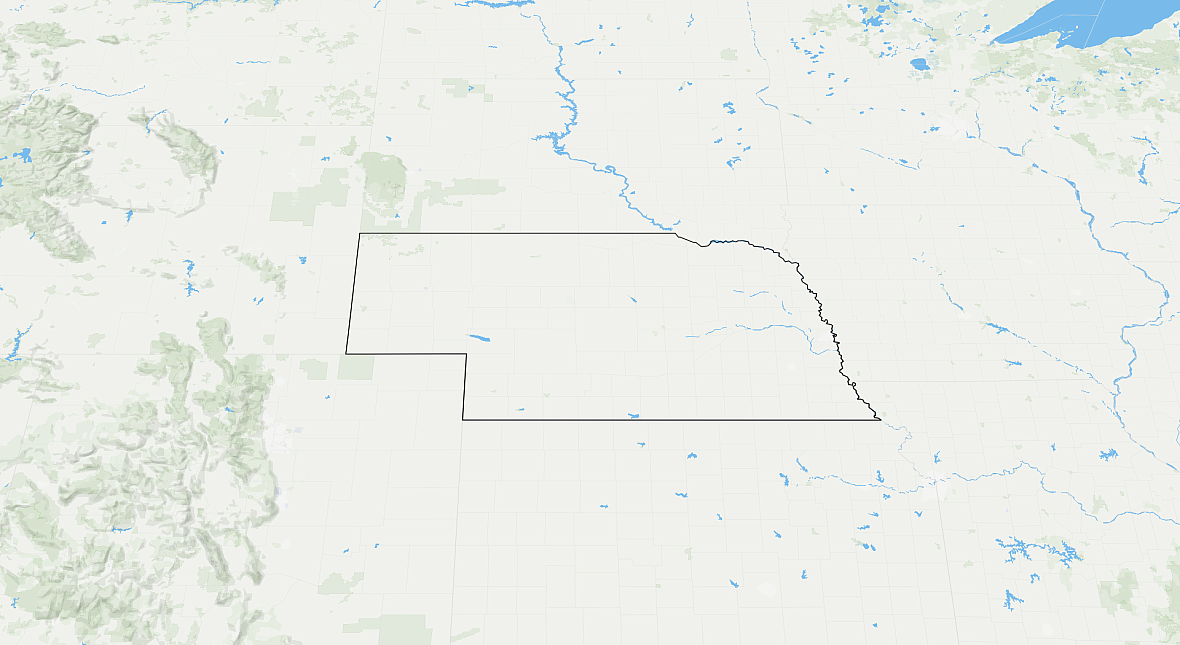
Flatwater Free Press
Many residents of Nebraska are unknowingly consuming nitrate, an odorless, colorless contaminant that’s widespread in the state’s groundwater. We consume it when we shower, when we cook, when we turn on our taps to get a glass of ice water to drink.

State and local governments test Nebraska wells — identified by the gray dots on the map — in part because we have long known water quality is a problem.
And the problem is getting worse – in the past three decades, the median statewide nitrate level has doubled.
These 6000-some red dots are wells that, when last tested, had a higher nitrate level than the EPA drinking water standard.
Experts suspect this level of nitrate – and even levels below the federal standard – is endangering our health and our children.
Standing in front of a big screen, Nick Herringer claps in time with a metronome. He draws lines on the screen, repeating patterns drawn by the computer. He identifies icons of cars when they flash before his eyes. This is the 22-year-old’s speech and cognitive therapy, which he has been doing at least twice a week. Every week. For three years.
Nick’s thick brown hair hides a massive, ear-to-ear scar from his four brain surgeries for glioblastoma, an aggressive brain cancer he has battled since he was a teenager. The lifelong Nebraska football fan had to quit playing football his freshman year at Hastings High School after his doctor told him: Your brain can’t withstand the hits.
His mom, Tammy Herringer, drives Nick to therapy and back to the quiet country home his dad Jay Herringer built for the family. She takes Nick along shopping and to community events because he can’t go alone after the cancer and a car accident that further damaged his brain.
“I have worn the paths back and forth to town all these years,” Tammy said.
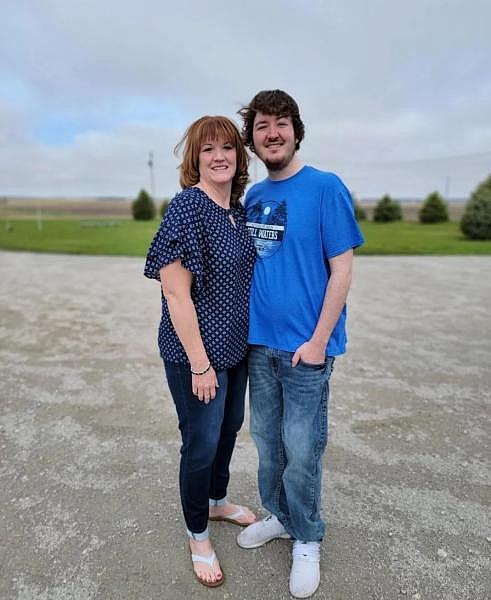
Nick Herringer and his mother Tammy Herringer stand in front of their house northwest of Hastings. Their water, drawn from their privately drilled well, showed a nitrate level of 18 parts per million earlier this year, much higher than the EPA limit of 10 ppm. Courtesy photo
Recently driving the gravel road from Hastings to their house northwest of town, she could barely peer beyond the endless rows of golden corn plants on both sides of the road, mile after mile, standing tall in the scorching sun.
This corn is the main crop of the number one industry in Nebraska. It’s a plant so important to the state that it’s in the name of Nick’s favorite team: The Cornhuskers. And it’s corn – what we spray onto it to make it thrive – that experts say may be the culprit behind many pediatric cancers like Nick’s.
Nitrogen fertilizer powers the corn’s growth. It also converts to nitrate as it seeps into the soil – right into the Herringers’ water and the drinking water of many Nebraskans.
This problem costs serious taxpayer money: Cities and small towns have spent untold millions of dollars treating the water they supply to their residents, struggling and sometimes failing to meet the Environmental Protection Agency’s drinking water standard of 10 parts per million.
Fifty-nine of Nebraska’s 500-odd community public water systems have violated the EPA standard at least once since 2010. Those who live in the country and get their water from private wells, like the Herringers, continue to bear the cost of treating their own nitrate-laced water.
This problem is growing worse: The statewide median nitrate level has doubled since 1978. Despite this, state and local governments have taken little action to regulate the farming practices that lead to nitrate leaching, say experts and local officials from both parties.
These authorities have never fined or stopped someone who is using too much nitrogen fertilizer, multiple leaders of Nebraska’s Natural Resources Districts told the Flatwater Free Press.
And this problem may have serious consequences for Nebraskans, including its youngest residents.
Nebraska has the seventh-highest pediatric cancer rate in the United States, according to the Centers for Disease Control and Prevention. It has the highest pediatric cancer rate of any state west of Pennsylvania.
High nitrate levels are closely linked to colorectal cancer, according to a leading expert at the National Cancer Institute. They are connected to thyroid disease. They’re associated with neural tube defects, a birth defect of the brain or spine that often kills young children who have it.
Pregnant people can be potentially harmed by ingesting nitrates, experts say, spurring complications including anemia, premature labor and miscarriage.
And the risks may be increasing for Nebraskans, roughly 85% of whom use groundwater. Nearly one-fifth of Nebraska now has an estimated nitrate level above 5 parts per million. That’s the third highest in the United States.
Nick had drunk this water for years as a child. He has showered in it and eaten food cooked in it all his life.
That whole time, the Herringer family had no idea that their private well had tested at a nitrate level of 30 parts per million in 2010. That’s 10 times the amount of nitrate that Eleanor Rogan, a top University of Nebraska Medical Center researcher now examining the link between high nitrate and childhood cancers, says she would allow small children to drink.
The Herringer’s water was worse than 99% of the wells then tested in and around Hastings, a few years before the family got the grim news in 2015: Nick had cancer.
When Nick and Tammy recently arrived home from one of Nick’s fall speech therapy appointments, they bumped into well driller Eric Jensen. Jensen had just finished putting chlorine in their well. He told Tammy that high nitrate is common around Hastings, pointing to the nearby feedlot in Juanita and those cornfields that surround her house as culprits.
Drilling a new well won’t solve the problem, he said. There’s only one way to remove nitrate from their tap water, the well driller told the mother: Install a complex filtration system.
It’s about $1,000. But he said it’s worth it.
“Nitrate ain’t good,” he told Tammy.
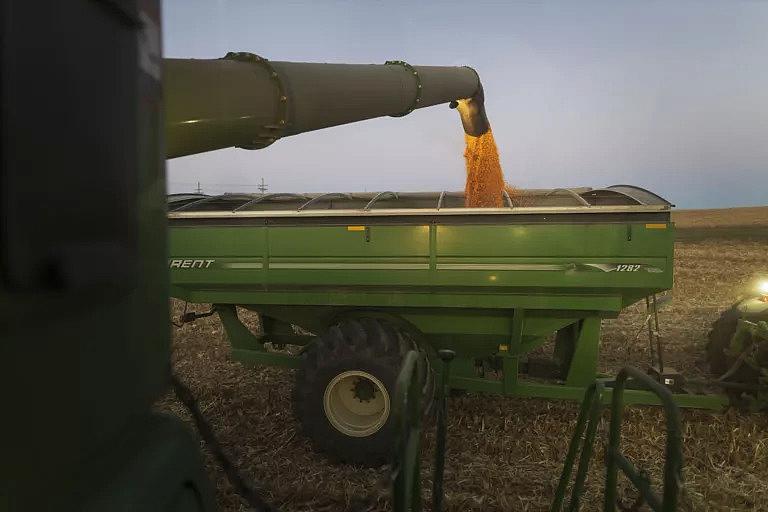
Farmer Jason Othmer unloads corn into a grain cart as he harvests near Vesta, an unincorporated community in Johnson County, Nebraska, on Tuesday evening, Oct. 18, 2022. Photo by Ryan Soderlin for the Flatwater Free Press
Nick was perfectly healthy growing up. So Tammy thought it was strange when he asked to stay home from school because of a headache in 2015. Tylenol did little to help.
He started complaining about the sunlight being so bright that he had to wear sunglasses all the time. He vomited inside a Walgreens kiosk as Tammy printed photos. He vomited several times at home. His headache would come back after he stopped taking his nausea medication and steroids prescribed by the doctor. After seeing little improvement for about three weeks, Tammy drove him to the emergency room.
There, a doctor did a CT scan and showed them the results: an orange-sized mass on Nick’s brain. They wheeled him into an ambulance and rushed him to Omaha. The diagnosis: a grade 4 brain tumor, the most aggressive form of primary brain cancers. Most glioblastoma patients don’t survive 18 months, the doctors told Tammy.
Pediatric cancer cases like Nick’s are becoming more common in Nebraska, especially childhood brain tumors, according to a study led by UNMC and the state health department that found an increase in both between 1990 and 2013.
Areas of the state that have higher pediatric cancer rates and birth defect rates also have higher nitrate levels, researchers say.
“Over some time, we identified that there is something in Nebraska that’s a little bit different,” said Dr. Don Coulter, who participated in the statewide cancer study. “It’s the Ogallala Aquifer.”
Nebraskans’ water is often clear, cool and drawn directly from the aquifer. The 174,000-square-mile High Plains aquifer is the largest source of groundwater in the United States, a lifeline for cattle, corn and families.
But when there’s nitrate in their drinking water, Nebraskans can’t taste or smell it.
Nitrate exists naturally. It’s in vegetables. It’s converted from manure produced by cattle. But it can also come from manmade sources like commercial fertilizers applied to your lawn, your neighborhood golf course, and especially to corn.
Crops need nitrogen to grow. But the nitrogen fertilizers applied to cornfields can’t all be absorbed by the plants. In Nebraska, roughly a third of nitrogen applied to corn is lost to leaching, according to the Nebraska Water Center. Some of that goes into our water supply.
Our bodies easily absorb nitrate in water and convert it into nitrite, which then could morph into organic compounds called nitrosamines.
Nitrosamines can cause cancer.
A UNMC research team headed by Rogan is now looking county by county, examining links between high nitrate and the rates of the three most common pediatric cancers.
Nebraska counties with slightly elevated nitrate levels showed a seven-fold increase in the leukemia rate when compared to counties with minimal nitrate levels, the research suggests. These counties had lymphoma rates four times higher than counties with low levels. These findings are preliminary, scientists caution, and need further investigation.
But the cancer most consistently linked to elevated nitrate levels: Childhood brain cancers like Nick’s. These central nervous system cancers are eight times as high as in counties with low nitrate.
Nick’s family didn’t know of these risks. Most Nebraskans don’t, either.
The state’s well water is rarely tested. Excluding public water systems, less than 4% of the roughly 180,000 registered wells are tested each year. And private wells, found in rural areas and not connected to a community’s water supply, aren’t required by state or federal law to be tested at all.
The Herringer family actually got their water tested once, when Hastings Utilities decided to test some wells outside its city limits. The city then mailed out the testing results. The Herringers missed the letter.
The Herringers didn’t know that nitrate levels in Hastings were high. They didn’t know their own nitrate levels were much higher.
Tammy said they had recently heard things about a potential cancer belt along the corn belt. They heard about poor water quality. But they never put the two together.
“You don’t think that this is going to happen to you,” she said. “I’m not saying that that’s what caused Nicholas’s diagnosis…How will we ever know?”
State leaders have been concerned about the nitrate seeping into our water for half a century.
The state’s environmental agencies started testing nitrate in the 1970s.
In 1986, then-Sen. Loran Schmit, a Republican from the village of Bellwood, near Columbus, spearheaded a bill to address increasing nitrate. The resulting law called on state agencies and local natural resources districts to come up with a management plan for areas with high nitrate concentrations.
But experts told the Flatwater Free Press that the state has not done enough to turn the tide. In the decades since Schmit first focused on nitrate, the state has continued to approve bigger feedlots. Nebraska farmers have grown more and more corn.
“The bill was to prevent groundwater contamination, and I do not know we have made progress in that direction,” Schmit, a lifelong farmer who is now 94, told the Flatwater Free Press in an interview in September.
A few years after Schmit’s bill, the EPA took its first major action to limit nitrate in drinking water.
It did so because it had become clear, both to scientists and then to the public after blaring news headlines, that high nitrate in water causes something called methemoglobinemia.
Its common name: “Blue baby syndrome.”
Blue baby syndrome causes developmental delay. It causes babies’ hearts to fail. And, at the time, it was killing an unknown number of young American children.
To respond, the federal government, in 1992, enacted its first-ever rule for how much nitrate would be allowed in drinking water. Ten parts per million, the rule said, reflecting studies that appeared to show that blue baby syndrome didn’t happen if nitrate levels dropped below that limit.
That limit hasn’t budged since. But decades of further study suggests that nitrate, even at levels below the EPA standard, is linked to potential health risks, including pediatric cancers, and birth defects.
Scientists are studying what these links mean.
They could mean that nitrate by itself causes cancer, or that it mobilizes other chemicals that lead to cancer. They could mean that nitrate becomes especially dangerous when mixed with other agrichemicals like atrazine or naturally occurring elements like uranium.
The mounting evidence that nitrate may be harmful is why Rogan believes water should contain less than 3 parts per million of nitrate before children drink it.
Some 48% of private wells were over Rogan’s suggested limit the last time they got tested, according to publicly available state water data.
“I think there’s just mounting evidence that the EPA standard for nitrate is too high,” she said. “I hope out of what we’re publishing and other people are publishing, that the acceptable standard is going to get lowered.”

University of Nebraska Medical Center researcher Eleanor Rogan poses for a portrait at the Maurer Center for Public Health on Friday, Oct. 21, 2022, in Omaha, Nebraska. Rogan is heading a team now studying the potential link between high nitrate in water and a number of serious health problems, including pediatric cancers, birth defects and Parkinson’s disease. Nebraska has one of the highest nitrate levels in the country, and also the highest pediatric cancer rate west of Pennsylvania. Photo by Ryan Soderlin for the Flatwater Free Press
Long before the first potential links between nitrate and cancer began to surface, Ila Foster let her two children drink from wells in Dundy County in southwest Nebraska.
After all, that’s what Foster grew up drinking. And what people nearby drank, no questions asked.
“I should have gotten my water checked down there,” she said. She never did.
Both Foster’s parents had colon cancer.
Then her 16-year-old daughter Nancy Mossburgh, who loved to garden, was diagnosed with rhabdomyosarcoma, an extremely rare form of aggressive cancer in her muscles.
Nancy died a year later in 1996.
Foster still owns the house where Nancy grew up. When she travels there, she brings bottled water.
“There’s no way I’m drinking that water out there,” she said.
Before any of their loved ones got cancer, her husband Loren Mossburgh, a farmer who raised cattle, wheat and milo, worried about agrichemicals. But her husband, who has since died, was unable to sway his fellow farmers.
“My husband, when he farmed out there, he got so upset with some of those people and he said ‘You know where those chemicals go to?’ He said our kids are gonna be paying for it.”
Water quality does play a pivotal role in community health, said Paul Black, former chair of the Department of Biochemistry at the University of Nebraska–Lincoln.
Poor water quality contributes to the failure of communities in Sub-Saharan Africa. The same goes for towns in the United States, he said.
“Nitrate is the key problem in Nebraska,” Black explained. “The kids are sicker so they don’t learn as well in school. So your community’s not as healthy because your kids now are having problems.”
Imagine looking at a map and zooming out so you can see the whole country, Black said. The chemical follows creeks and rivers all the way into the mighty Mississippi River and past New Orleans into the Gulf of Mexico.
Nebraska stands out on this map, Black said. It’s in red, a “hot zone.”
“I would say Nebraska is the epicenter in the upper Midwest.”
This spring, Tylr Naprstek, assistant manager of the Lower Loup Natural Resources District, waited his turn to speak to the NRD board in another district.
The meeting went long. Many of the white-haired farmers sitting in the audience left for home.
Finally it was Naprstek’s turn. He rose, stood at a lectern and described the reaction when an area north of Columbus was designated a management area in 2019 – after nitrate readings skyrocketed to as high as 48 parts per million.
“Everyone was pointing fingers,” he told the members of the Lower Elkhorn NRD board and the few remaining attendees. “This half of the room says, ‘Well it’s the manure guys over there that are doing it all,’ and …[feedlot owners were] saying ‘It’s the commercial fertilizer guys’.”
It’s the classic blame game, described to the Flatwater Free Press by multiple local officials, NRD board members and water quality experts.
Dan Snow, a lab director at the Nebraska Water Center, has a tool that can pinpoint who’s to blame.
It’s a process called “fingerprinting,” that allows Snow’s lab to measure the amount of nitrate and identify whether it’s coming from organic sources like manure, or commercial fertilizer.
Which means that, in the case of the 48-parts-per-million test near Columbus, Snow can tell you that the answer is, essentially, “all of the above.”
Manure from feedlots played a significant role. So did commercial fertilizer.
But that’s not the case across Nebraska.
Testing done by Snow’s lab consistently shows that the majority of nitrate comes from commercial fertilizers – what we spray on our lawns, golf courses, but most of all on corn.
“I’m guessing more than 90% [comes] from commercial fertilizer,” Snow told the Flatwater Free Press.
Where is it worst?
Sky-high nitrate levels appear to be particularly threatening to Nebraskans living near river valleys in central and northeast Nebraska, according to well data.
The state’s two largest cities, Omaha and Lincoln, have low nitrate levels, but some smaller communities surrounding them show elevated levels.
In central Nebraska, on both sides of the river from Kearney to northwest of Hastings, a band of recently tested wells showed nitrate levels higher than the EPA limit. Between the Platte River and Lower Loup River is a corridor of cities flanked by high-nitrate wells, including Kearney, Grand Island and Columbus.
The Elkhorn River, which originates in north-central Nebraska and moves east, has seen high nitrate in its watershed. Pierce, Knox and Holt counties all had a mean nitrate level over 10 ppm between 1987 and 2016.
In this area, a 756-square-mile span of land was designated a groundwater protection area. Four natural resources districts established the Bazile Management Area to address rising nitrate by promoting education on farming practices.
In addition, river valleys near York saw increasing nitrate levels high enough to trigger restrictions on how farmers can apply anhydrous ammonia.
The Little Blue watershed in southern Nebraska is home to Edgar and Steele City, two villages that have been on a state administrative order for continual nitrate violations for years. Both are exploring plans to build their own water treatment facilities.
Some conditions make it more likely: shallow water tables, sandy soil texture and heavy irrigation, Snow explained.
Nebraska Farm Bureau President Mark McHargue knows that his hometown Central City fits this profile. The Platte River Valley, where his family is from, was the first in the state to observe the presence of high nitrate in their water a half-century ago.
“As farmers, we live in those communities. I have eight grandchildren. I want them to have good drinking water,” he said.
And the Nebraska Farm Bureau president points out that he and others have changed some farming practices to try to make that possible.
In the past few decades, his family farm has tested the nitrate in their soil. He factors in what’s already in the soil when calculating how much the crop needs.
His family also applies hog manure as a source of fertilizer in small amounts, a method known as “split application,” which reduces the amount of nitrate that seeps into the water. “Quite frankly, it’s a hassle. But we know in our sandy soils we can’t hold as much nitrogen,” he said.
Ray Ward runs a leading soil and water testing lab in Nebraska, and has been doing so for a long time – he founded the lab in Kearney 40 years ago.
When he started, some farmers used up to 350 pounds of nitrogen per acre to produce between 120 and 150 bushels of corn. That’s more than double UNL’s current recommended nitrogen-corn ratio.
“Farmers were pumping too much water and leaching the nitrate out,” Ward said. “And the corn had turned yellow, so they just put more nitrogen on the next year.”
Though the problem started decades ago, recent tests show an increase of nitrate in soils of large swaths of the state.
Snow hopes his “fingerprinting” findings will help Nebraska move beyond years of finger-pointing between farmers and feedlot owners to the next stage: finding solutions.
Snow’s study in the Hastings area – the area where the Herringers live – reveals that nitrate stored beneath irrigated cropland in that NRD increased by 30% between 2011 and 2016.
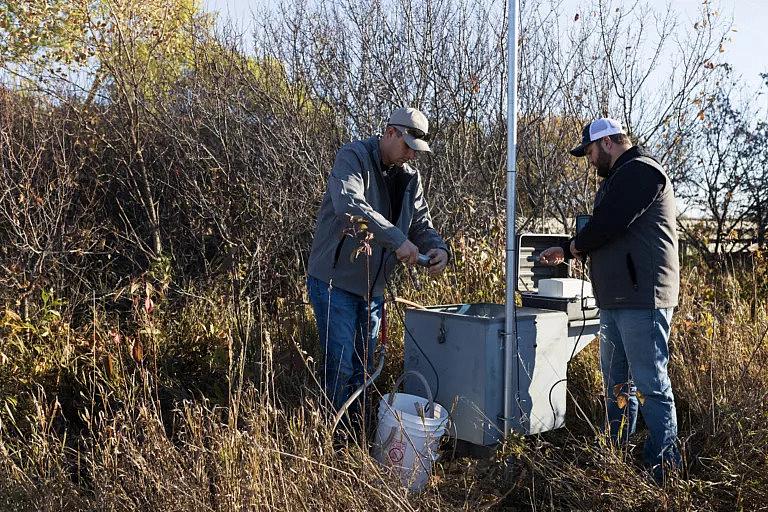
Water resources technicians Josh Schnitzler and Connor Baldwin, who both work for the Lower Elkhorn Resources District in Norfolk, prepare to test the water in a monitoring well near the north fork of the Elkhorn River. They were working at a nested location of three wells that run from shallow to more deep and are used to monitor groundwater for nitrates and other substances like solids and sulfates. The wells are located about 10 miles northwest of Elkhorn. Photo by Ryan Soderlin for the Flatwater Free Press
And Hastings manifests a bigger problem across Nebraska.
Statewide, contaminated areas with nitrate above the EPA standard have continued to expand since the 1970s, particularly in the eastern part of the state, according to two recent studies.
Public water systems in these areas, big and small, are hemorrhaging money to treat high nitrate.
Creighton, pop. 1,147 in Knox County, spent $1.3 million on building the state’s first reverse osmosis treatment system to filter out nitrate in 1993.
Seward, a city about half an hour west of Lincoln, spent $5 million.
Hastings spent $15 million on theirs.
To Norfolk Mayor Josh Moenning, Creighton’s response to rising nitrate levels felt like a “canary in the coal mine” moment.
“If we don’t get to some kind of solution here and get a handle on this problem, it’s only going to cost us more and more and into the future,” he said. “And it’s going to cost us in terms of negative health impacts.”
“We all have a role to play – rural community leaders and elected officials, too.”
***
A few months before Nick Herringer’s diagnosis, the Adams Central Patriots, the high school down the road from the Herringers’ home, played an away game against the Aurora Huskies. It was Childhood Cancer Awareness Night. Gary Peters, an Aurora father who lost his son Jacob to lymphoma in 2011, walked onto the field to read out one name after another.
“Stand up if you knew Alyssa Sandmeier.”
“Stand up if you knew Tyler Larson.”
“Stand up if you knew Jacob Peters.”
“Stand up if you knew Sydnee Owens.”
By the end, almost everyone in the stadium was standing.
All were children. All, including Peters’ son Jacob, died of childhood cancer. To him, the seven pediatric cancer cases in Aurora from 2005 to 2013 seemed like a “waterfall” of different cancer diagnoses out of nowhere.
UNMC researchers have also found an association between pediatric cancer and atrazine, an herbicide many farmers say they have already phased out. (Editor’s note: A previous version of this story incorrectly suggested that atrazine has already been completely phased out.) Rogan’s team is further expanding the studies to uranium and arsenic.
After seeing the UNMC research, Peters wondered if Jacob’s lymphoma and death were related to the water they consumed. They were on a private well. They used the water for cooking and showering.
A 2013 study identified a three-fold chance of non-Hodgkin lymphoma in areas where there was both high nitrate and atrazine. Noting “awfully suspicious” overlap between high atrazine and high pediatric cancer areas, Peters said he suspects a mix of different agrichemicals leads to pediatric cancers like his son’s.

Gary Peters and Shari Peters sit in the living room of their home in Aurora on Saturday, Oct. 22, 2022, while Shari holds a photo of their son Jacob, who died of lymphoma on Nov. 16, 2011, at the age of 17. The Peters have concerns about nitrate in Nebraska’s drinking water and its possible link to pediatric cancers. Gary Peters said it isn’t enough to avoid drinking contaminated water. Bathing and cooking with it should worry Nebraskans, too, he said. Photo by Ryan Soderlin for the Flatwater Free Press
He said lawmakers need to make people aware of this “silent battle.”
“How long is it gonna [take to] change, to get legislation that outlaws these chemicals that could give our kids cancer? There’s no definite time,” Peters said. “There’s just too many dollars involved. And the people making those decisions are only concerned about the bottom line. They’re not really concerned about kids getting cancer.”
He’s frustrated at the status quo. Policymakers have known about nitrate for more than 40 years. Little has changed.
Natural resources districts in the state, created 50 years ago for local management of water resources in each watershed, have been taking painstaking steps toward battling nitrate.
“It takes tough decisions,” said Mike Sousek, manager of the Lower Elkhorn NRD in the northeastern part of the state. He and his team have been encouraging farmers to adopt practices that benefit the environment, such as growing cover crops. Farmers can receive government funding for doing so.
“I got millions of dollars. I can’t even spend it. I can’t get people to sign up just to try to change [their practices],” he said. “Money isn’t enough of a carrot.”
The stick isn’t there either.
Then-Sen. Schmit designed a mechanism to protect groundwater safety – the state environmental protection authority and local NRDs should work together.
Neither the Nebraska Department of Environment and Energy nor NRDs have issued a cease and desist order to or fined a single person for using too much nitrogen fertilizer or applying excessive manure in the state, NRD leaders said.
Regulators don’t even know how much nutrient gets applied to the ground, and how much remains in the soil.
***
Nick has fought vomiting and seizures with a sense of calmness.
“I prayed a lot,” he said.
Tammy said her son’s personality changed since his second surgery. She doesn’t hear his nonstop whistling anymore. He has become quieter. He’s more succinct.
Nick has tried taking college classes online, but he tires easily.
After almost a year of stable health while on oral chemotherapy, Nick recently learned his tumor has again grown. His family is exploring his next treatment plan.
He knows one thing. He won’t have another surgery.
“Nick always says ‘I’m in a win-win situation. If I beat this cancer, then I beat a cancer that’s very aggressive. And if I don’t, then I will be in heaven with Jesus, and that is a win-win,’” Tammy said.
Nick, sitting nearby, nods his head. “That gives me goosebumps,” he said.
For now, Nick continues the fight that Nancy, Jacob, and many other Nebraskan children have already lost.
“Experts are telling us this is affecting our children. There are real life and death situations being played out here,” Sousek said. “We have to start paying attention. It’s our kids.”
How do I test my water?
To look up public water testing data for wells outside of cities, you can use the interactive tool from the Nebraska Groundwater Quality Clearinghouse. If you are on public water and wish to learn about your city’s water quality, visit the NDEE’s Drinking Water Watch website and search for your community.
To test nitrate levels in your water, you can buy test strips that identify high nitrate levels. UNL’s Citizens Science program offers free testing for contaminants, including nitrate, to those who sign up. You can also call your local NRD about testing services for private wells. You can find your local NRD and their contact information here.
If your water nitrate level is above 10 ppm, avoid drinking it, the CDC says. Boiling water will not lower the nitrate level and make it safe to drink. You can contact your local health officials and utilities for recommendations. You can refer to this CDC document.
The Flatwater Free Press is Nebraska’s first independent, nonprofit newsroom focused on investigations and feature stories that matter.
This article was produced as a project for the University of Southern California Annenberg Center for Health Journalism’s 2022 National Fellowship.


